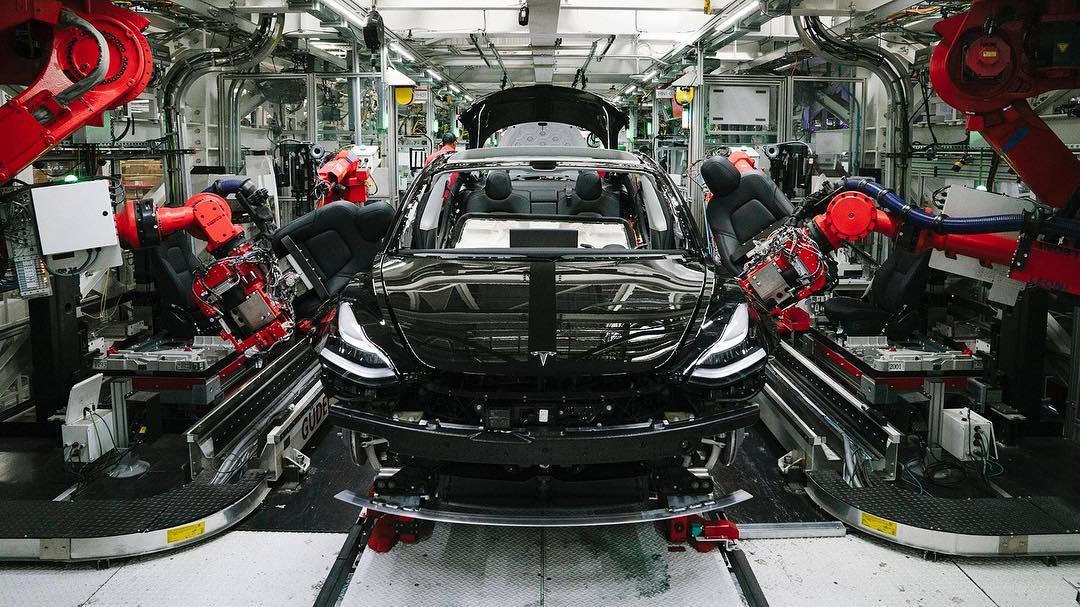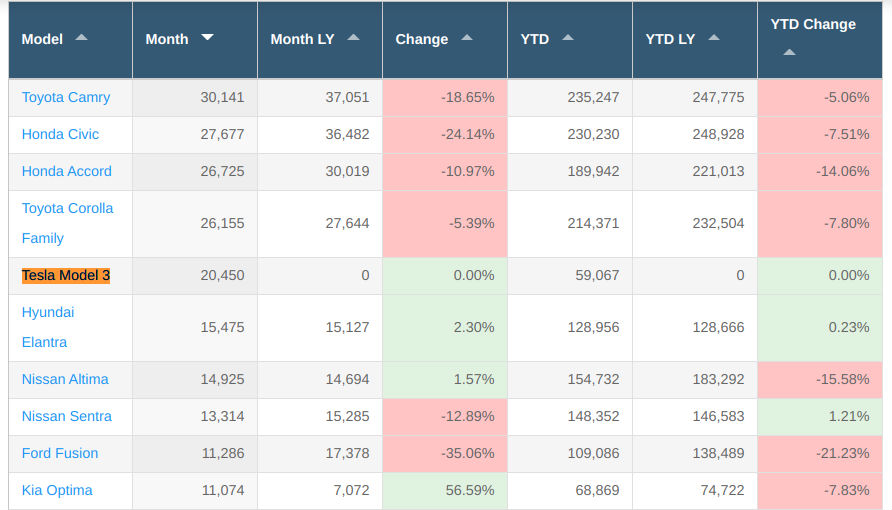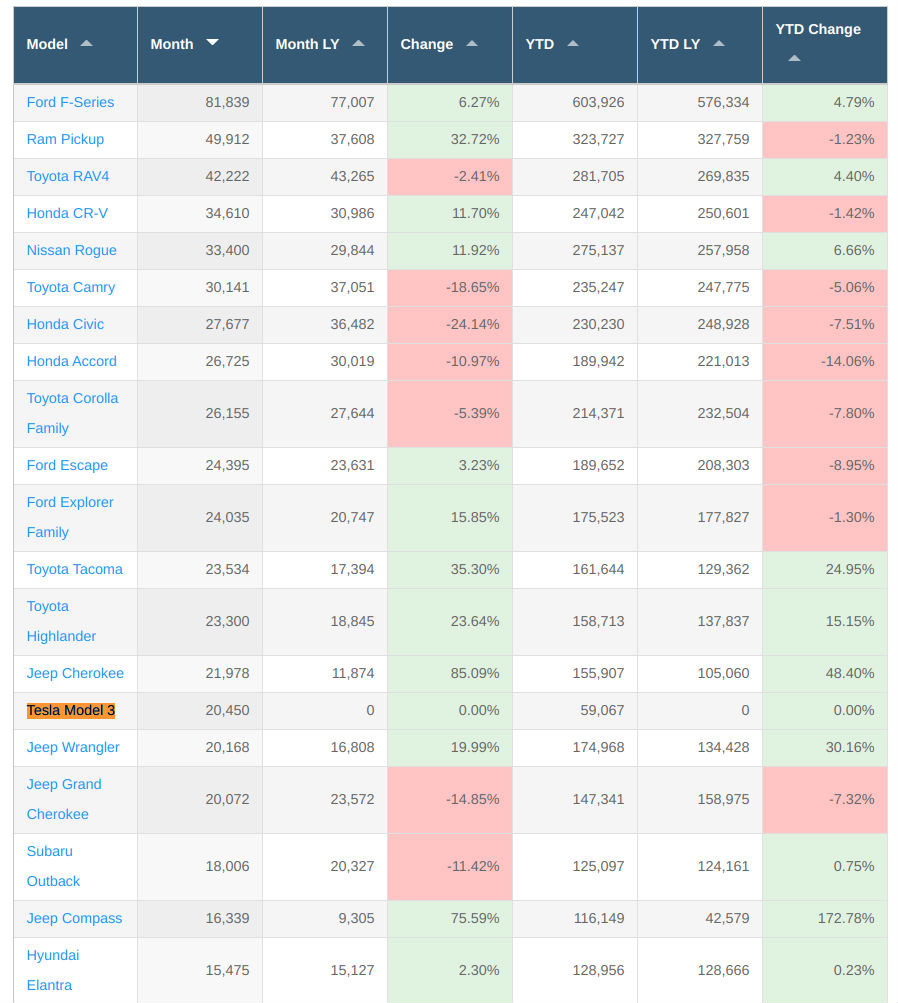

Investor's Corner
Tesla Model 3 becomes August’s 5th best-selling passenger car, 15th in US’ overall auto sales
Tesla took longer than expected to ramp the production of the Model 3, but now the company is finally hitting its manufacturing stride, and the electric sedan is starting to make waves in the US auto industry — some very serious waves.
Auto sales tracking website GoodCarBadCar has posted the estimated sales figures of car manufacturers currently operating in the United States in August. Based on their August 2018 data, the Tesla Model 3 has become America’s 5th best-selling passenger car. The electric car’s rankings for August is up two places from its rank in July, when the Model 3 was listed as the 7th best-selling passenger car in the US.
The auto sales tracking website now lists the Model 3 directly behind the big four of the US passenger car segment — the Toyota Camry, the Honda Civic, the Honda Accord, and the Toyota Corolla Family — all of which are lower-priced than the electric car. The Model 3’s strong August sales figures allowed it to overtake two more affordable vehicles in GCBC‘s rankings as well, the Hyundai Elantra and the Nissan Altima.

The Tesla Model 3 is not just establishing itself as a formidable competitor in the US’ passenger car market, either. The Model 3 also made it to the Top 20 of GoodCarBadCar‘s overall rankings for US auto sales, which include SUVs and trucks such as the best-selling Ford F-150, the Dodge RAM, the Toyota Rav4, and the Honda CR-V. So far, the Model 3 is 15th on the overall list for August, beating out popular SUVs such as the Jeep Wrangler, Jeep Grand Cherokee, and the Subaru Outback.
The Model 3’s estimated August sales are quite impressive, considering that Tesla is still in the process of ramping the production of the electric car. Tesla, after all, plans to eventually build 10,000 Model 3 per week, and so far, the company is only producing around half of that number weekly.

Tesla ended Q2 2018 on a strong note, producing 5,000 Model 3 vehicles in a seven-day period. Despite this milestone, the company’s critics are highly skeptical that Tesla would be able to maintain its optimum production numbers. That said, over the first two months of Q3, Tesla appears to have taken it upon itself to prove its critics wrong.
During the Q2 2018 earnings call, Elon Musk mentioned that Tesla was able to maintain a production rate of 5,000 Model 3 per week during “multiple weeks” in July. In August, the company also showed encouraging signs about the electric car’s production. Tesla’s VIN registrations for the Model 3, for one, rocketed past the 100,000-vehicle mark, and Bloomberg‘s online Model 3 production tracker even showed a week where the company seemed to have produced more than 6,000 units of the electric sedan in a seven-day period.
Perhaps the most notable vote of confidence for the company’s Model 3 production ramp came from veteran auto analyst George Galliers from Evercore ISI, who was given an extensive tour of the Fremont factory, including the newly built GA4 set up on the grounds of the facility. The analyst later published a report about his visit, noting that Tesla is well on its way to sustaining a weekly production rate of 5,000-6,000 Model 3 per week.
“Tesla seems well on the way to achieving a steady weekly production rate of 5,000 to 6,000 units per week. We are incrementally positive on Tesla following our visit. We have confidence in their production. We did not see anything to suggest that Model 3 cannot reach 6k units per week and 7k to 8k with very little incremental capital expenditure. Focusing on the fundamentals and setting aside talk of privatization, we are incrementally positive on Tesla following our visit,” Galliers noted.

Investor's Corner
Tesla stock closes at all-time high on heels of Robotaxi progress

Tesla stock (NASDAQ: TSLA) closed at an all-time high on Tuesday, jumping over 3 percent during the day and finishing at $489.88.
The price beats the previous record close, which was $479.86.
Shares have had a crazy year, dipping more than 40 percent from the start of the year. The stock then started to recover once again around late April, when its price started to climb back up from the low $200 level.
This week, Tesla started to climb toward its highest levels ever, as it was revealed on Sunday that the company was testing driverless Robotaxis in Austin. The spike in value pushed the company’s valuation to $1.63 trillion.
Tesla Robotaxi goes driverless as Musk confirms Safety Monitor removal testing
It is the seventh-most valuable company on the market currently, trailing Nvidia, Apple, Alphabet (Google), Microsoft, Amazon, and Meta.
Shares closed up $14.57 today, up over 3 percent.
The stock has gone through a lot this year, as previously mentioned. Shares tumbled in Q1 due to CEO Elon Musk’s involvement with the Department of Government Efficiency (DOGE), which pulled his attention away from his companies and left a major overhang on their valuations.
However, things started to rebound halfway through the year, and as the government started to phase out the $7,500 tax credit, demand spiked as consumers tried to take advantage of it.
Q3 deliveries were the highest in company history, and Tesla responded to the loss of the tax credit with the launch of the Model 3 and Model Y Standard.
Additionally, analysts have announced high expectations this week for the company on Wall Street as Robotaxi continues to be the focus. With autonomy within Tesla’s sights, things are moving in the direction of Robotaxi being a major catalyst for growth on the Street in the coming year.
Elon Musk
Tesla needs to come through on this one Robotaxi metric, analyst says
“We think the key focus from here will be how fast Tesla can scale driverless operations (including if Tesla’s approach to software/hardware allows it to scale significantly faster than competitors, as the company has argued), and on profitability.”

Tesla needs to come through on this one Robotaxi metric, Mark Delaney of Goldman Sachs says.
Tesla is in the process of rolling out its Robotaxi platform to areas outside of Austin and the California Bay Area. It has plans to launch in five additional cities, including Houston, Dallas, Miami, Las Vegas, and Phoenix.
However, the company’s expansion is not what the focus needs to be, according to Delaney. It’s the speed of deployment.
The analyst said:
“We think the key focus from here will be how fast Tesla can scale driverless operations (including if Tesla’s approach to software/hardware allows it to scale significantly faster than competitors, as the company has argued), and on profitability.”
Profitability will come as the Robotaxi fleet expands. Making that money will be dependent on when Tesla can initiate rides in more areas, giving more customers access to the program.
There are some additional things that the company needs to make happen ahead of the major Robotaxi expansion, one of those things is launching driverless rides in Austin, the first city in which it launched the program.
This week, Tesla started testing driverless Robotaxi rides in Austin, as two different Model Y units were spotted with no occupants, a huge step in the company’s plans for the ride-sharing platform.
Tesla Robotaxi goes driverless as Musk confirms Safety Monitor removal testing
CEO Elon Musk has been hoping to remove Safety Monitors from Robotaxis in Austin for several months, first mentioning the plan to have them out by the end of 2025 in September. He confirmed on Sunday that Tesla had officially removed vehicle occupants and started testing truly unsupervised rides.
Although Safety Monitors in Austin have been sitting in the passenger’s seat, they have still had the ability to override things in case of an emergency. After all, the ultimate goal was safety and avoiding any accidents or injuries.
Goldman Sachs reiterated its ‘Neutral’ rating and its $400 price target. Delaney said, “Tesla is making progress with its autonomous technology,” and recent developments make it evident that this is true.
Investor's Corner
Tesla gets bold Robotaxi prediction from Wall Street firm
Last week, Andrew Percoco took over Tesla analysis for Morgan Stanley from Adam Jonas, who covered the stock for years. Percoco seems to be less optimistic and bullish on Tesla shares, while still being fair and balanced in his analysis.

Tesla (NASDAQ: TSLA) received a bold Robotaxi prediction from Morgan Stanley, which anticipates a dramatic increase in the size of the company’s autonomous ride-hailing suite in the coming years.
Last week, Andrew Percoco took over Tesla analysis for Morgan Stanley from Adam Jonas, who covered the stock for years. Percoco seems to be less optimistic and bullish on Tesla shares, while still being fair and balanced in his analysis.
Percoco dug into the Robotaxi fleet and its expansion in the coming years in his latest note, released on Tuesday. The firm expects Tesla to increase the Robotaxi fleet size to 1,000 vehicles in 2026. However, that’s small-scale compared to what they expect from Tesla in a decade.
Tesla expands Robotaxi app access once again, this time on a global scale
By 2035, Morgan Stanley believes there will be one million Robotaxis on the road across multiple cities, a major jump and a considerable fleet size. We assume this means the fleet of vehicles Tesla will operate internally, and not including passenger-owned vehicles that could be added through software updates.
He also listed three specific catalysts that investors should pay attention to, as these will represent the company being on track to achieve its Robotaxi dreams:
- Opening Robotaxi to the public without a Safety Monitor. Timing is unclear, but it appears that Tesla is getting closer by the day.
- Improvement in safety metrics without the Safety Monitor. Tesla’s ability to improve its safety metrics as it scales miles driven without the Safety Monitor is imperative as it looks to scale in new states and cities in 2026.
- Cybercab start of production, targeted for April 2026. Tesla’s Cybercab is a purpose-built vehicle (no steering wheel or pedals, only two seats) that is expected to be produced through its state-of-the-art unboxed manufacturing process, offering further cost reductions and thus accelerating adoption over time.
Robotaxi stands to be one of Tesla’s most significant revenue contributors, especially as the company plans to continue expanding its ride-hailing service across the world in the coming years.
Its current deployment strategy is controlled and conservative to avoid any drastic and potentially program-ruining incidents.
So far, the program, which is active in Austin and the California Bay Area, has been widely successful.








